Visual and Colorimetric Sensing of Metsulfuron-Methyl by Exploiting Hydrogen Bond-Induced Anti-Aggregation of Gold Nanoparticles in the Presence of Melamine
Abstract
:1. Introduction
2. Materials and Methods
2.1. Chemicals and Apparatus
2.2. Synthesis of AuNPs
2.3. Colorimetric Assay
2.4. Sample Pretreatment
3. Results
3.1. Characterization
3.2. Colorimetric Sensing Mechanism
3.3. Optimization of Method
3.3.1. Effect of Melamine Concentration
3.3.2. Effect of pH
3.4. Colorimetric Sensing of Metsulfuron-Methyl
3.5. Selectivity
3.6. Application to Agricultural Irrigation Water
4. Conclusions
Author Contributions
Funding
Conflicts of Interest
References
- Rejczak, T.; Tuzimski, T. Simple, cost-effective and sensitive liquid chromatography diode array detector method for simultaneous determination of eight sulfonylurea herbicides in soya milk samples. J. Chromatogr. A 2016, 1473, 56–65. [Google Scholar] [CrossRef] [PubMed]
- Acebal, C.C.; Grünhut, M.; Llamas, N.E.; Insausti, M.; Zelená, L.; Sklenářová, H.; Solich, P.; Band, B.S.F. An integrated on-line method for the preconcentration and simultaneous determination of metsulfuron methyl and chlorsulfuron using oxidized carbon nanotubes and second order fluorescent data. Microchem. J. 2016, 129, 90–97. [Google Scholar] [CrossRef]
- Acebal, C.C.; Grünhut, M.; Šrámková, I.; Chocholouš, P.; Lista, A.G.; Sklenářová, H.; Solich, P.; Band, B.S.F. Application of a fully integrated photodegradation-detection flow-batch analysis system with an on-line preconcentration step for the determination of metsulfuron methyl in water samples. Talanta 2014, 129, 233–240. [Google Scholar] [CrossRef] [PubMed]
- Alesso, M.; Almeida, C.A.; Talio, M.C.; Fernández, L.P. Metsulfuron-methyl determination in environmental samples by solid surface fluorescence. Microchem. J. 2018, 139, 150–154. [Google Scholar] [CrossRef]
- Da Silva, A.; Deda, D.; da Róz, A.; Prado, R.; Carvalho, C.; Viviani, V.; Leite, F. Nanobiosensors Based on Chemically Modified AFM Probes: A Useful Tool for Metsulfuron-Methyl Detection. Sensors 2013, 13, 1477–1480. [Google Scholar] [CrossRef] [PubMed]
- Yan, R.; Ju, F.; Wang, H.; Sun, C.; Zhang, H.; Shao, M.; Wang, Y. Determination of sulfonylurea herbicides in soil by ionic liquid-based ultrasonic-assisted extraction high-performance liquid chromatography. Anal. Methods 2014, 6, 9561–9566. [Google Scholar] [CrossRef]
- Cotterill, E.G. Determination of the sulfonylurea herbicides chlorsulfuron and metsulfuron-methyl in soil, water and plant material by gas chromatography of their pentafluorobenzyl derivatives. Pestic. Sci. 1992, 34, 291–296. [Google Scholar] [CrossRef]
- Ye, G.; Zhang, W.; Cui, X.; Pan, C.; Jiang, S. Determination and Quantitation of Ten Sulfonylurea Herbicides in Soil Samples Using Liquid Chromatography with Electrospray Ionization Mass Spectrometric Detection. Chin. J. Anal. Chem. 2006, 34, 1207–1212. [Google Scholar] [CrossRef]
- Yan, C.; Zhang, B.; Liu, W.; Feng, F.; Zhao, Y.; Du, H. Rapid determination of sixteen sulfonylurea herbicides in surface water by solid phase extraction cleanup and ultra-high-pressure liquid chromatography coupled with tandem mass spectrometry. J. Chromatogr. B 2011, 879, 3484–3489. [Google Scholar] [CrossRef] [PubMed]
- Rouchaud, J.; Moulard, C.; Eelen, H.; Bulcke, R. Persistence of the sulfonylurea herbicide iodosulfuron-methyl in the soil of winter wheat crops. Toxicol. Environ. Chem. 2003, 85, 103–120. [Google Scholar] [CrossRef]
- Yakovleva, J.; Knopp, D.; Niessner, R.; Eremin, S.A. Development of a Polarization Fluoroimmunoassay for the Herbicide Metsulfuron-Methyl. Food Agric. Immunol. 2002, 14, 217–229. [Google Scholar] [CrossRef]
- Springer, V.H.; Lista, A.G. A simple and fast method for chlorsulfuron and metsulfuron methyl determination in water samples using multiwalled carbon nanotubes (MWCNTs) and capillary electrophoresis. Talanta 2010, 83, 126–129. [Google Scholar] [CrossRef] [PubMed]
- Liu, G.; Yang, X.; Li, T.; Yu, H.; Du, X.; She, Y.; Wang, J.; Wang, S.; Jin, F.; Jin, M.; et al. Spectrophotometric and visual detection of the herbicide atrazine by exploiting hydrogen bond-induced aggregation of melamine-modified gold nanoparticles. Microchim. Acta 2015, 182, 1983–1989. [Google Scholar] [CrossRef]
- Huang, P.-C.; Gao, N.; Li, J.-F.; Wu, F.-Y. Colorimetric detection of methionine based on anti-aggregation of gold nanoparticles in the presence of melamine. Sens. Actuators B Chem. 2018, 255, 2779–2784. [Google Scholar] [CrossRef]
- Hormozi-Nezhad, M.R.; Abbasi-Moayed, S. A sensitive and selective colorimetric method for detection of copper ions based on anti-aggregation of unmodified gold nanoparticles. Talanta 2014, 129, 227–232. [Google Scholar] [CrossRef] [PubMed]
- Liu, W.; Zhang, D.; Zhu, W.; Zhang, S.; Wang, Y.; Yu, S.; Liu, T.; Zhang, X.; Zhang, W.; Wang, J. Colorimetric and visual determination of total nereistoxin-related insecticides by exploiting a nereistoxin-driven aggregation of gold nanoparticles. Microchim. Acta 2015, 182, 401–408. [Google Scholar] [CrossRef]
- Chen, G.-H.; Chen, W.-Y.; Yen, Y.-C.; Wang, C.-W.; Chang, H.-T.; Chen, C.-F. Detection of Mercury(II) Ions Using Colorimetric Gold Nanoparticles on Paper-Based Analytical Devices. Anal. Chem. 2014, 86, 6843–6849. [Google Scholar] [CrossRef] [PubMed]
- Baetsen-Young, A.M.; Vasher, M.; Matta, L.L.; Colgan, P.; Alocilja, E.C.; Day, B. Direct colorimetric detection of unamplified pathogen DNA by dextrin-capped gold nanoparticles. Biosens. Bioelectron. 2018, 101, 29–36. [Google Scholar] [CrossRef] [PubMed]
- Rohit, J.V.; Singhal, R.K.; Kailasa, S.K. Dithiocarbamate-calix[4]arene functionalized gold nanoparticles as a selective and sensitive colorimetric probe for assay of metsulfuron-methyl herbicide via non-covalent interactions. Sens. Actuators B Chem. 2016, 237, 1044–1055. [Google Scholar] [CrossRef]
- Zhou, M.; Lin, T.; Gan, X. Colorimetric aggregation assay for silver(I) based on the use of aptamer modified gold nanoparticles and C-Ag(I)-C interaction. Microchim. Acta 2017, 184, 4671–4677. [Google Scholar] [CrossRef]
- Safavi, A.; Ahmadi, R.; Mohammadpour, Z. Colorimetric sensing of silver ion based on anti aggregation of gold nanoparticles. Sens. Actuators B Chem. 2017, 242, 609–615. [Google Scholar] [CrossRef]
- Guo, J.; Zhang, Y.; Luo, Y.; Shen, F.; Sun, C. Efficient fluorescence resonance energy transfer between oppositely charged CdTe quantum dots and gold nanoparticles for turn-on fluorescence detection of glyphosate. Talanta 2014, 125, 385–392. [Google Scholar] [CrossRef] [PubMed]
- Zhang, X.; Sun, Z.; Cui, Z.; Li, H. Ionic liquid functionalized gold nanoparticles: Synthesis, rapid colorimetric detection of imidacloprid. Sens. Actuators B Chem. 2014, 191, 313–319. [Google Scholar] [CrossRef]
- Liu, G.; Wang, S.; Yang, X.; Li, T.; She, Y.; Wang, J.; Zou, P.; Jin, F.; Jin, M.; Shao, H. Colorimetric sensing of atrazine in rice samples using cysteamine functionalized gold nanoparticles after solid phase extraction. Anal. Methods 2016, 8, 52–56. [Google Scholar] [CrossRef]
- Wang, X.; Yang, Y.; Dong, J.; Bei, F.; Ai, S. Lanthanum-functionalized gold nanoparticles for coordination–bonding recognition and colorimetric detection of methyl parathion with high sensitivity. Sens. Actuators B Chem. 2014, 204, 119–124. [Google Scholar] [CrossRef]
- Liu, G.; Huang, X.; Zheng, S.; Li, L.; Xu, D.; Xu, X.; Zhang, Y.; Lin, H. Novel triadimenol detection assay based on fluorescence resonance energy transfer between gold nanoparticles and cadmium telluride quantum dots. Dyes Pigments 2018, 149, 229–235. [Google Scholar] [CrossRef]
- Liang, X.; Wei, H.; Cui, Z.; Deng, J.; Zhang, Z.; You, X.; Zhang, X.-E. Colorimetric detection of melamine in complex matrices based on cysteamine-modified gold nanoparticles. Analyst 2011, 136, 179–183. [Google Scholar] [CrossRef] [PubMed]
- Liu, S.; Du, Z.; Li, P.; Li, F. Sensitive colorimetric visualization of dihydronicotinamide adenine dinucleotide based on anti-aggregation of gold nanoparticles via boronic acid–diol binding. Biosens. Bioelectron. 2012, 35, 443–446. [Google Scholar] [CrossRef] [PubMed]
- Chen, L.; Lu, W.; Wang, X.; Chen, L. A highly selective and sensitive colorimetric sensor for iodide detection based on anti-aggregation of gold nanoparticles. Sens. Actuators B Chem. 2013, 182, 482–488. [Google Scholar] [CrossRef]
- Ding, N.; Zhao, H.; Peng, W.; He, Y.; Zhou, Y.; Yuan, L.; Zhang, Y. A simple colorimetric sensor based on anti-aggregation of gold nanoparticles for Hg2+ detection. Colloids Surf. A 2012, 395, 161–167. [Google Scholar] [CrossRef]
- Jin, W.; Huang, P.; Wei, G.; Cao, Y.; Wu, F. Visualization and quantification of Hg2+ based on anti-aggregation of label-free gold nanoparticles in the presence of 2-mercaptobenzothiazole. Sens. Actuators B Chem. 2016, 233, 223–229. [Google Scholar] [CrossRef]
- Chang, C.-C.; Chen, C.-Y.; Chen, C.-P.; Lin, C.-W. Facile colorimetric detection of human chorionic gonadotropin based on the peptide-induced aggregation of gold nanoparticles. Anal. Methods 2015, 7, 29–33. [Google Scholar] [CrossRef]
- Zhang, M.; Qing, G.; Xiong, C.; Cui, R.; Pang, D.W.; Sun, T. Dual-Responsive Gold Nanoparticles for Colorimetric Recognition and Testing of Carbohydrates with a Dispersion-Dominated Chromogenic Process. Adv. Mater. 2013, 25, 749–754. [Google Scholar] [CrossRef] [PubMed]
- Xianyu, Y.; Xie, Y.; Wang, N.; Wang, Z.; Jiang, X. A Dispersion-Dominated Chromogenic Strategy for Colorimetric Sensing of Glutathione at the Nanomolar Level Using Gold Nanoparticles. Small 2015, 11, 5510–5514. [Google Scholar] [CrossRef] [PubMed]
- Chen, W.; Deng, H.H.; Hong, L.; Wu, Z.Q.; Wang, S.; Liu, A.L.; Xia, X.H. Bare gold nanoparticles as facile and sensitive colorimetric probe for melamine detection. Analyst 2012, 137, 5382–5386. [Google Scholar] [CrossRef] [PubMed]
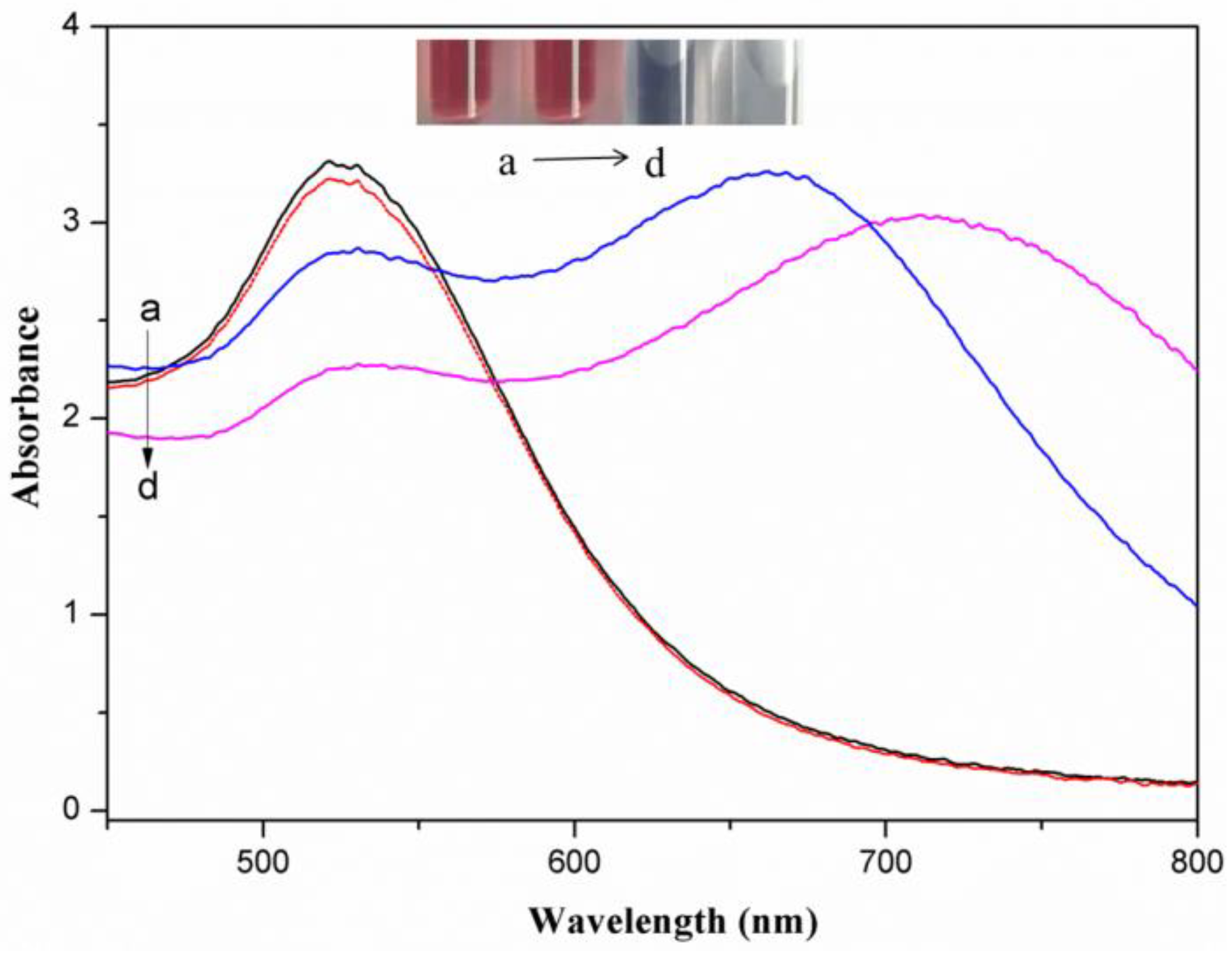
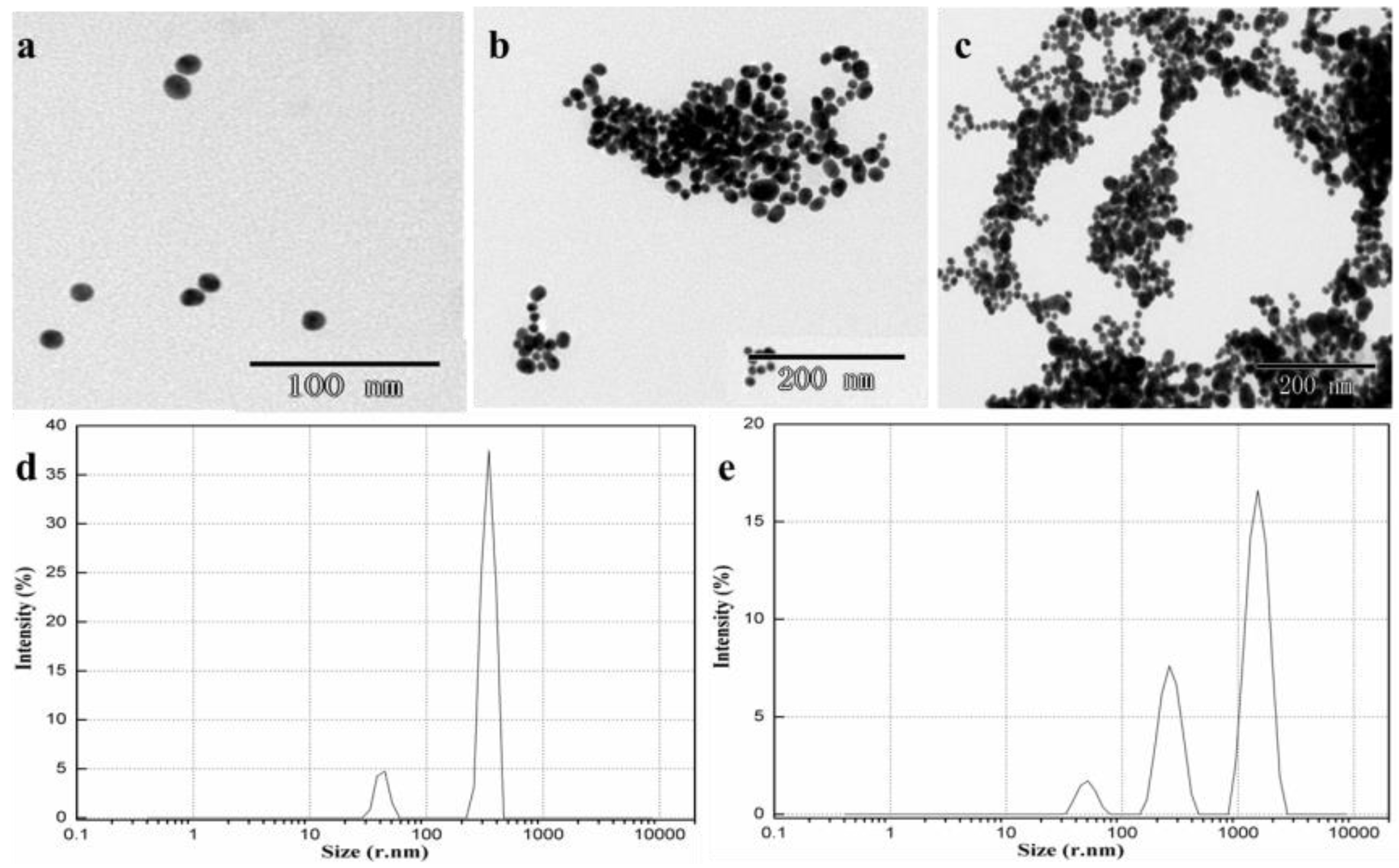
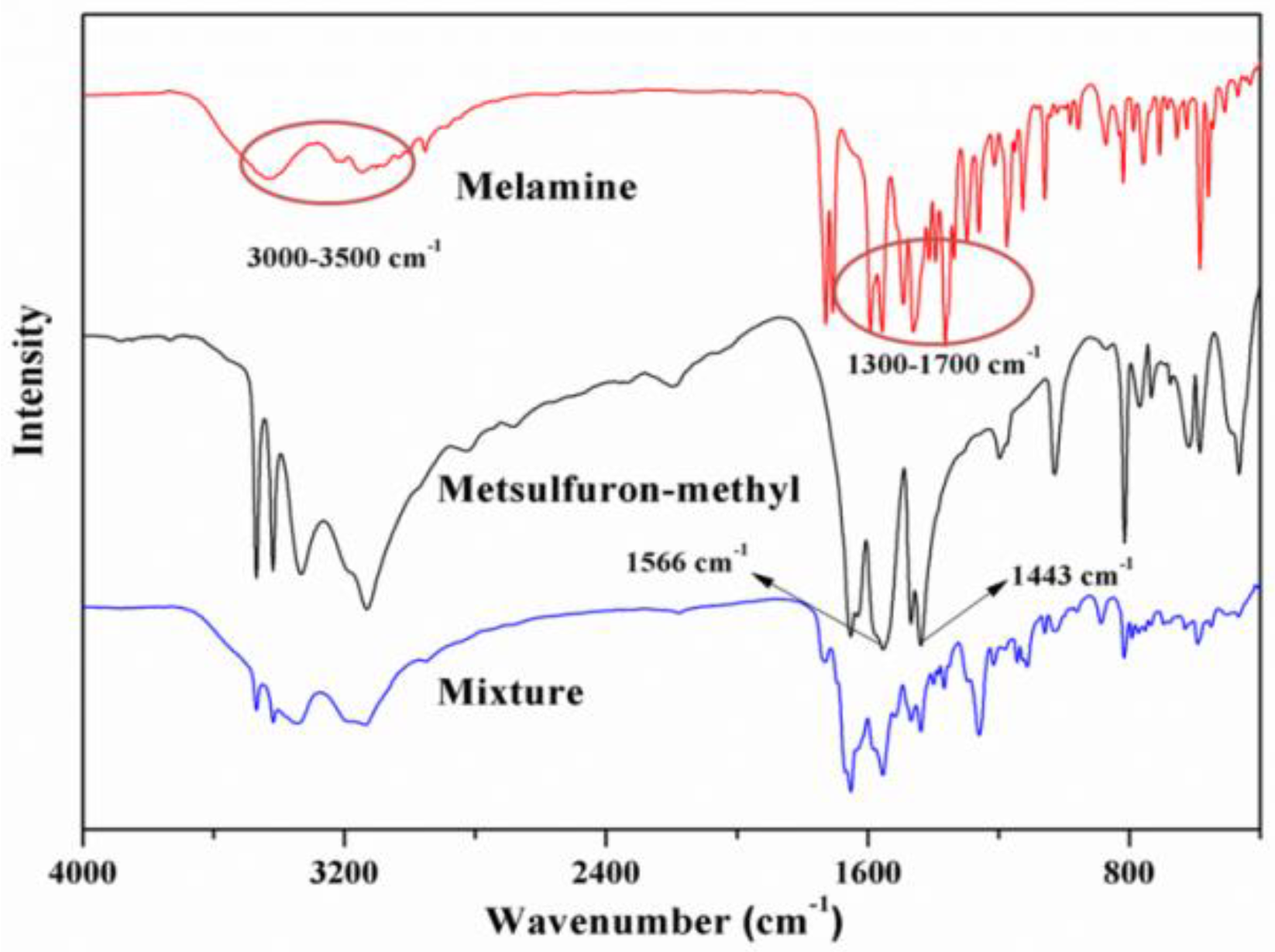
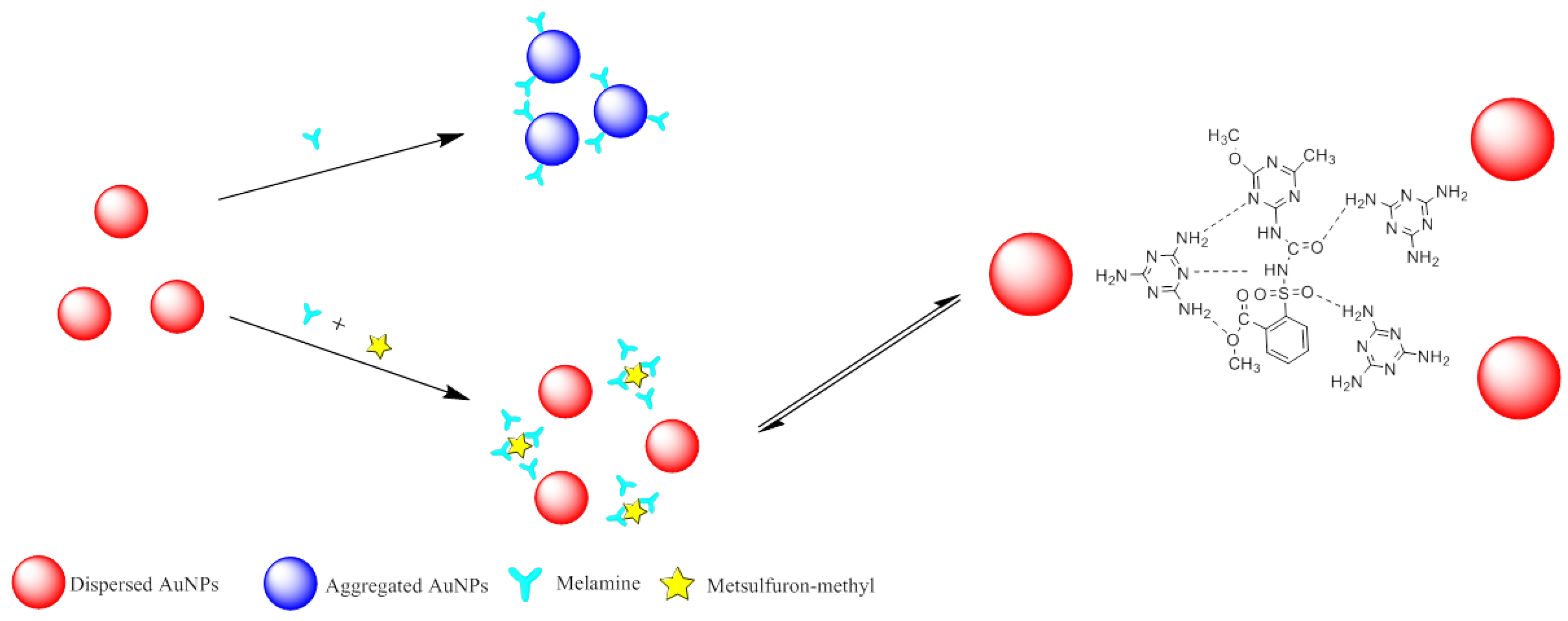
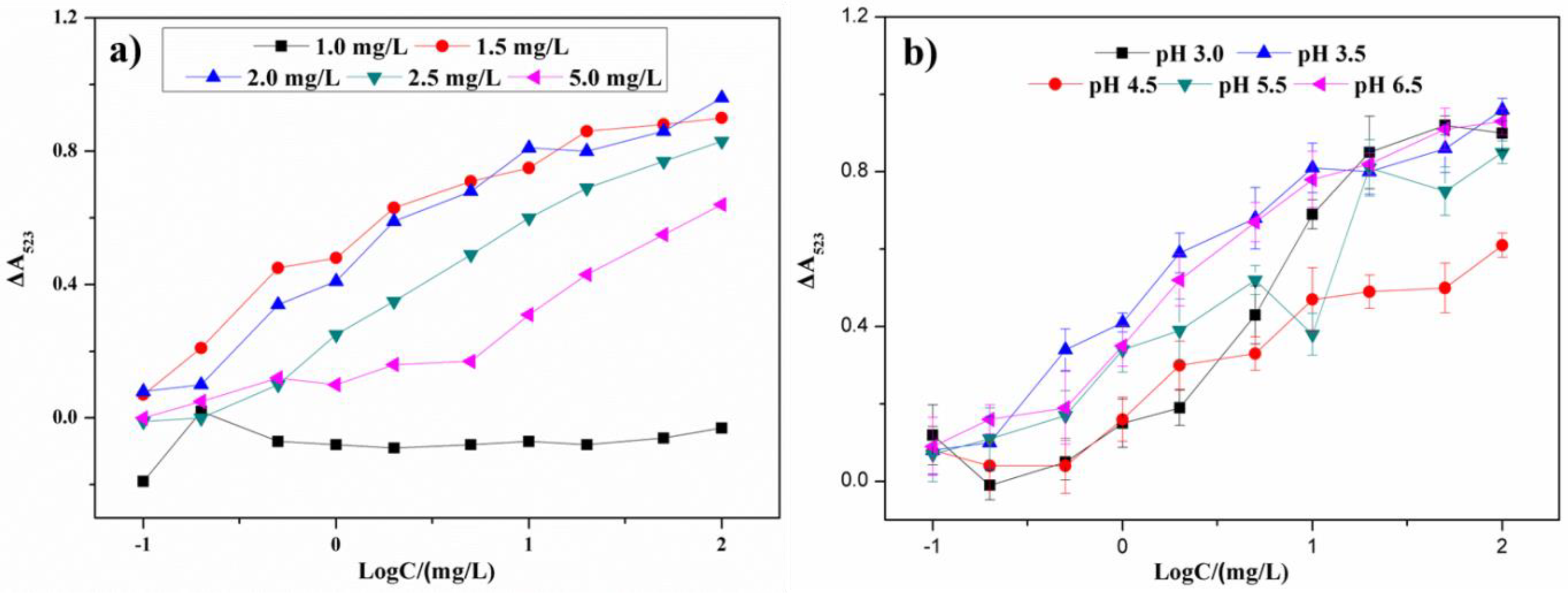
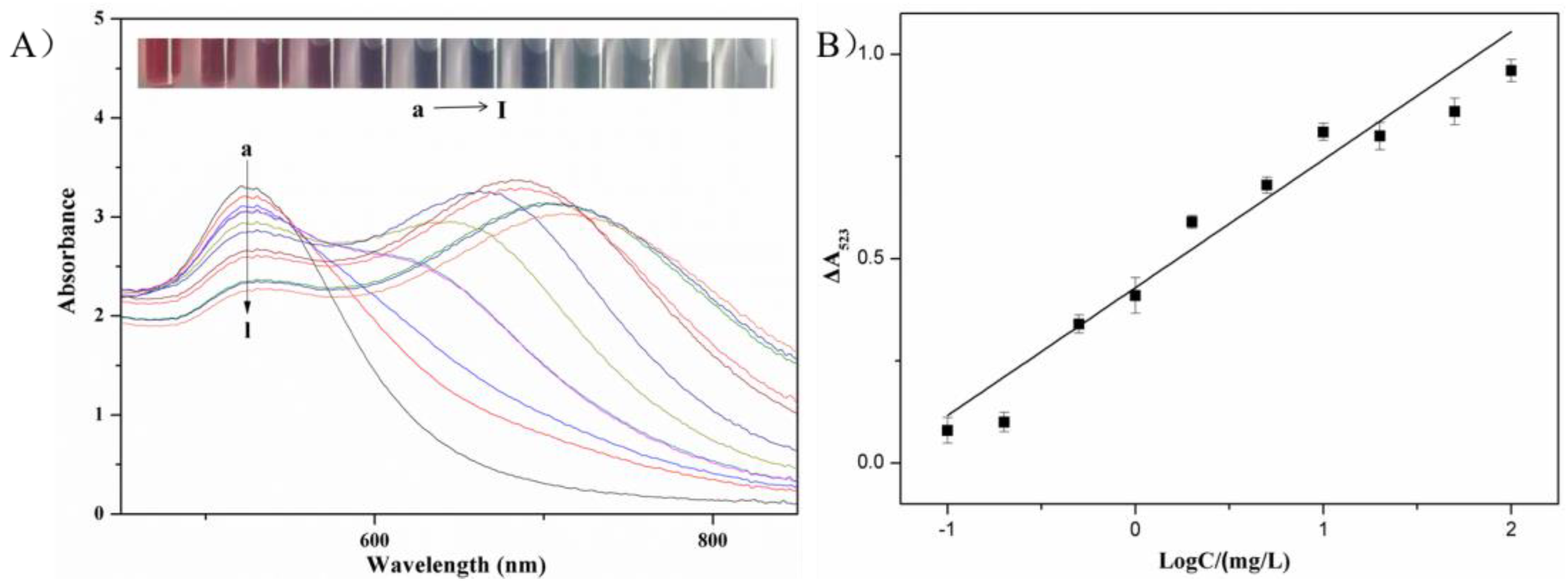
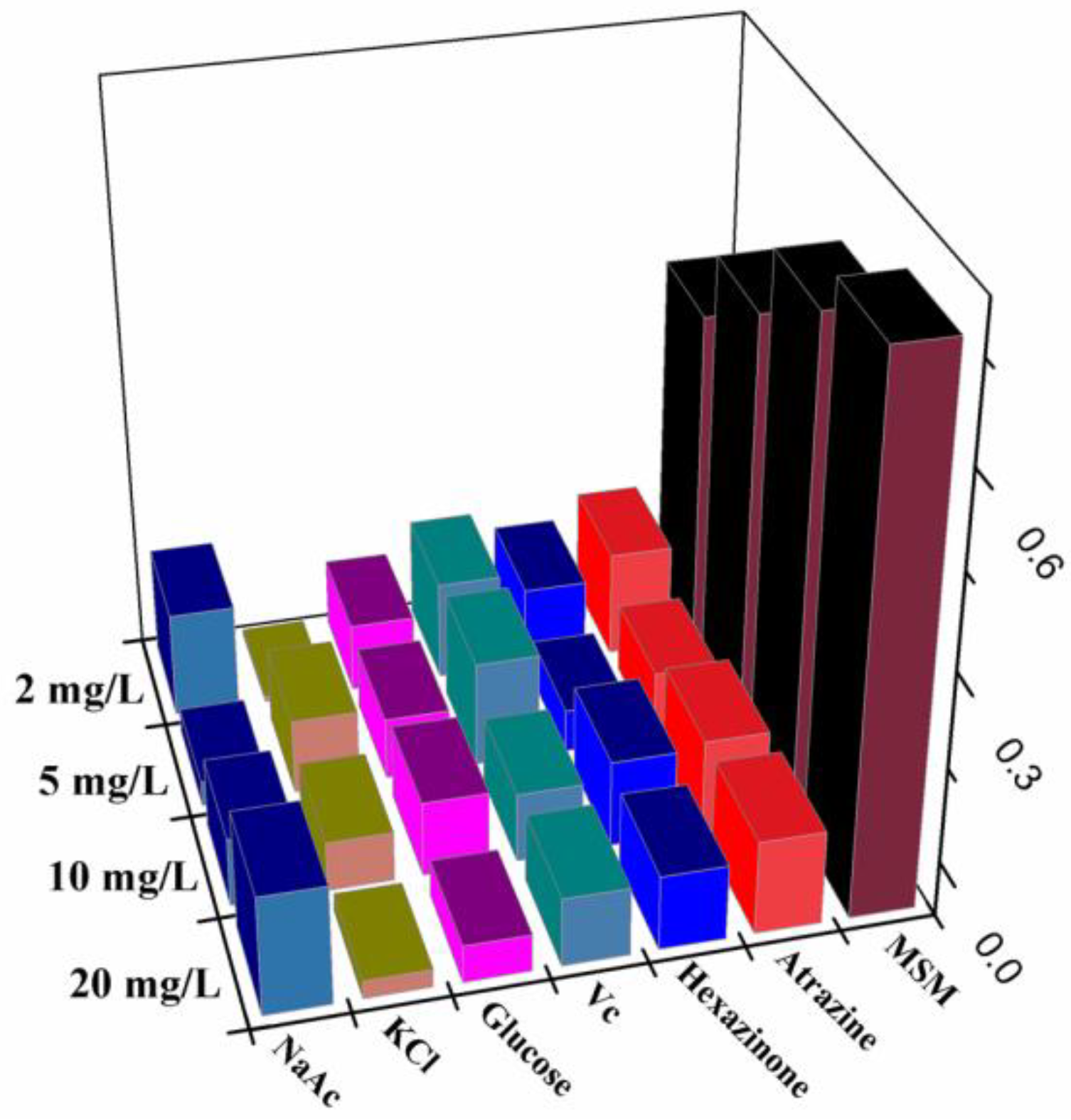
| Methods | Linear Range (mg/L) | LOD (mg/L) | R2 | Matrices | Reference |
|---|---|---|---|---|---|
| HPLC-DAD | 0.2–5 | 0.03 | 0.999 | Soya milk | [1] |
| HPLC-UV | 0.05–5 | 0.011 | 0.999 | Soil | [6] |
| Immunoassay | - | 0.005 | 0.990 | Environmental water | [11] |
| DTC-PTBCA-AuNPs based UV-vis detection | 0.381–19.1 | 0.0724 | 0.996 | Environmental water | [19] |
| Anti-aggregation-AuNPs based UV-vis detection | 0.1–100 | 0.05 | 0.957 | Irrigation water | This work |
| Samples | Spiked (mg/L) | Found (mg/L) | Recovery (%) | RSD (%) | LOD (mg/L) |
|---|---|---|---|---|---|
| Tap water | 0 | - | - | - | 0.25 |
| 0.5 | 0.372 | 74.3 | 6.37 | ||
| 1.0 | 0.852 | 85.2 | 5.46 | ||
| 5.0 | 4.66 | 93.1 | 4.73 | ||
| Well water | 0 | - | - | - | 0.5 |
| 0.5 | 0.356 | 71.2 | 5.72 | ||
| 1.0 | 0.886 | 88.6 | 3.81 | ||
| 5.0 | 5.02 | 100.4 | 6.52 |
© 2018 by the authors. Licensee MDPI, Basel, Switzerland. This article is an open access article distributed under the terms and conditions of the Creative Commons Attribution (CC BY) license (http://creativecommons.org/licenses/by/4.0/).
Share and Cite
Liu, G.; Zhang, R.; Huang, X.; Li, L.; Liu, N.; Wang, J.; Xu, D. Visual and Colorimetric Sensing of Metsulfuron-Methyl by Exploiting Hydrogen Bond-Induced Anti-Aggregation of Gold Nanoparticles in the Presence of Melamine. Sensors 2018, 18, 1595. https://doi.org/10.3390/s18051595
Liu G, Zhang R, Huang X, Li L, Liu N, Wang J, Xu D. Visual and Colorimetric Sensing of Metsulfuron-Methyl by Exploiting Hydrogen Bond-Induced Anti-Aggregation of Gold Nanoparticles in the Presence of Melamine. Sensors. 2018; 18(5):1595. https://doi.org/10.3390/s18051595
Chicago/Turabian StyleLiu, Guangyang, Ruonan Zhang, Xiaodong Huang, Lingyun Li, Naixin Liu, Jing Wang, and Donghui Xu. 2018. "Visual and Colorimetric Sensing of Metsulfuron-Methyl by Exploiting Hydrogen Bond-Induced Anti-Aggregation of Gold Nanoparticles in the Presence of Melamine" Sensors 18, no. 5: 1595. https://doi.org/10.3390/s18051595




